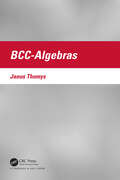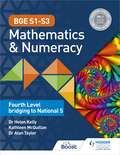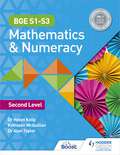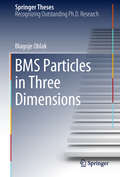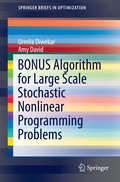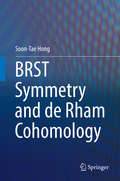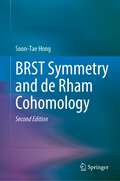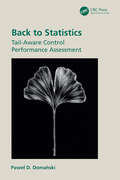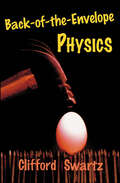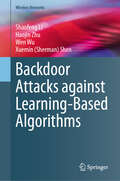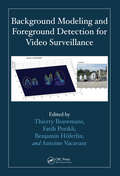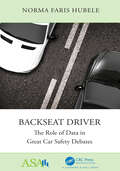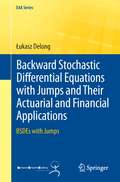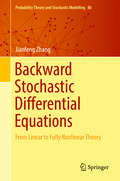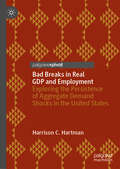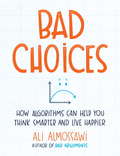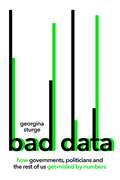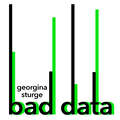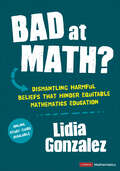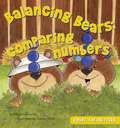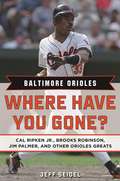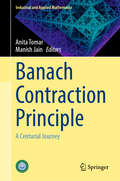- Table View
- List View
BCC-Algebras
by Janus ThomysThe subjects described in this book are BCC-algebras and an even wider class of weak BCC-algebras. The aim of the book is to summarize the achievements to date in the subject and to present them in the form of a logically created theory. Through appropriate grading and a precise description of the steps of the proofs, this theory is easily assimilated, and it should not take too long for the reader to learn about it. We begin with the motivation for their creation, many examples, and basic results used later in the book. Then we deal with the constructions of BCC-algebras and calculate the numbers of their subalgebras. The author describes the so-called solid weak BCC-algebras. They have some properties of BCI-algebras, but this requires completely new, often difficult, proofs. The important subclasses of weak BCC-algebras and the relationships between them are presented with many examples. BCC-Algebras is intended for researchers dealing with abstract algebra and for logicians working on the border between logic and algebra. The book is also of interest to students interested in the theory of (weak) BCC-algebras or simply in abstract algebra. The structure of the book makes it possible to discover topics that require further research, which, depending on the degree of difficulty, may be completed with a thesis or dissertation.
BGE S1–S3 Mathematics & Numeracy: Fourth Level bridging to National 5
by Dr Helen Kelly Dr Alan Taylor Kate McQuillanSyllabus: CfE (Curriculum for Excellence, from Education Scotland) and SQALevel: BGE S1-3: Fourth LevelSubject: Mathematics & NumeracyAim high and build confidence with this rigorous approach. Pupils are guided through mathematical concepts with worked examples, plenty of practice and opportunities to check that skills are secure before moving on.Covering all CfE Fourth Level Benchmarks (with bridging material to prepare for N5), this ready-made and differentiated course puts progression for every pupil at the heart of your curriculum.> Make new learning manageable: Each concept is introduced through step-by-step explanations and progressive worked examples, with proven methods for mastering difficult concepts> Apply knowledge and practise skills: Pupils are encouraged to test and explore their understanding of new concepts by completing exercises that gradually build in difficulty - with answers provided at the back of the book> Lay firm foundations for National qualifications: Key skills required for N5 Maths are covered in greater depth within the context of Fourth Level topics, giving pupils and teachers a head start in S4> Meet the needs of each pupil in your class: The explanations and activities are designed to ensure accessibility for those with low prior attainment, while coverage of higher order thinking skills will challenge and extend high achieving pupils> Effectively check and assess progress: 'Check-up' exercises at the end of each chapter consolidate learning and support formative assessment, helping you to monitor progression against the Experiences & Outcomes and Benchmarks> Deliver the 'responsibility for all' Es and Os: Plenty of activities that address literacy and health and wellbeing skills are threaded through the book
BGE S1–S3 Mathematics & Numeracy: Second Level
by Dr Helen Kelly Dr Alan Taylor Kate McQuillanMotivate and nurture every pupil with bespoke support and inclusive, age-appropriate content for those working towards Second Level Maths in secondary schools.This rigorous approach guides learners through mathematical concepts with worked examples, plenty of practice and opportunities to check that skills are secure before moving on.Covering all CfE Second Level Benchmarks, this ready-made and differentiated course puts progression for all pupils at the heart of your curriculum.> Make new learning manageable: Each concept is introduced through step-by-step explanations and progressive worked examples, with proven methods for mastering more difficult concepts> Apply knowledge and practise skills: Pupils are encouraged to test and explore their understanding of new concepts by completing exercises that gradually build in difficulty - with answers included at the back of the book> Meet the needs of each pupil in your class: The explanations and activities are designed to ensure accessibility for all, while extension tasks provide further stretch and challenge> Effectively check and assess progress: 'Check-up' exercises at the end of each chapter consolidate learning and support formative assessment, helping you to monitor progression against the Experiences & Outcomes and Benchmarks> Deliver the 'responsibility for all' Es and Os: Plenty of activities that address literacy and health and wellbeing skills are threaded through the book
BMS Particles in Three Dimensions (Springer Theses)
by Blagoje OblakThis thesis presents the state of the art in the study of Bondi-Metzner-Sachs (BMS) symmetry and its applications in the simplified setting of three dimensions. It focuses on presenting all the background material in a pedagogical and self-contained manner to enable readers to fully appreciate the original results that have been obtained while learning a number of fundamental concepts in the field along the way. This makes it a highly rewarding read and a perfect starting point for anybody with a serious interest in the four-dimensional problem.
BONUS Algorithm for Large Scale Stochastic Nonlinear Programming Problems (SpringerBriefs in Optimization)
by Urmila Diwekar Amy DavidThis book presents the details of the BONUS algorithm and its real world applications in areas like sensor placement in large scale drinking water networks, sensor placement in advanced power systems, water management in power systems, and capacity expansion of energy systems. A generalized method for stochastic nonlinear programming based on a sampling based approach for uncertainty analysis and statistical reweighting to obtain probability information is demonstrated in this book. Stochastic optimization problems are difficult to solve since they involve dealing with optimization and uncertainty loops. There are two fundamental approaches used to solve such problems. The first being the decomposition techniques and the second method identifies problem specific structures and transforms the problem into a deterministic nonlinear programming problem. These techniques have significant limitations on either the objective function type or the underlying distributions for the uncertain variables. Moreover, these methods assume that there are a small number of scenarios to be evaluated for calculation of the probabilistic objective function and constraints. This book begins to tackle these issues by describing a generalized method for stochastic nonlinear programming problems. This title is best suited for practitioners, researchers and students in engineering, operations research, and management science who desire a complete understanding of the BONUS algorithm and its applications to the real world.
BRST Symmetry and de Rham Cohomology
by Soon-Tae HongThis book provides an advanced introduction to extended theories of quantum field theory and algebraic topology, including Hamiltonian quantization associated with some geometrical constraints, symplectic embedding and Hamilton-Jacobi quantization and Becci-Rouet-Stora-Tyutin (BRST) symmetry, as well as de Rham cohomology. It offers a critical overview of the research in this area and unifies the existing literature, employing a consistent notation. Although the results presented apply in principle to all alternative quantization schemes, special emphasis is placed on the BRST quantization for constrained physical systems and its corresponding de Rham cohomology group structure. These were studied by theoretical physicists from the early 1960s and appeared in attempts to quantize rigorously some physical theories such as solitons and other models subject to geometrical constraints. In particular, phenomenological soliton theories such as Skyrmion and chiral bag models have seen a revival following experimental data from the SAMPLE and HAPPEX Collaborations and these are discussed. The book describes how these model predictions were shown to include rigorous treatments of geometrical constraints because these constraints affect the predictions themselves. The application of the BRST symmetry to the de Rham cohomology contributes to a deep understanding of Hilbert space of constrained physical theories. Aimed at graduate-level students in quantum field theory, the book will also serve as a useful reference for those working in the field. An extensive bibliography guides the reader towards the source literature on particular topics.
BRST Symmetry and de Rham Cohomology
by Soon-Tae HongThis book provides an advanced introduction to extended theories of quantum field theory and algebraic topology, including Hamiltonian quantization associated with some geometrical constraints, symplectic embedding and Hamilton-Jacobi quantization and Becchi-Rouet-Stora-Tyutin (BRST) symmetry, as well as de Rham cohomology. This extended new edition offers a multifaced insight into phenomenology of particles such as baryons and photons, in terms of extended objects. In particular, in the second edition, the baryons are described in hypersphere soliton model, and the photon properties are additionally included in stringy photon model and in Dirac type relativistic quantum mechanics for a photon.It offers a critical overview of the research in this area and unifies the existing literatures, employing a consistent notation. Although the results presented apply in principle to all alternative quantization schemes, special emphasis is placed on the BRST quantization and its de Rham cohomology group which contribute to a deep understanding of constrained physical theories. The book describes how solitons and other models subject to constraints include rigorous treatments of the geometrical constraints which affect the predictions themselves. The book is intended for use by any graduate-level student with quantum field and relativity theories, and it also serves as a useful reference for those working in the field. An extensive bibliography guides the reader toward the source literature on particular topics.
BWL-Formeln für Dummies (Für Dummies)
by Tobias AmelyFormeln und Kennzahlen verstehen, berechnen und interpretieren. Sind betriebswirtschaftliche Formeln für Sie ein Buch mit sieben Siegeln? Das lässt sich ändern! Tobias Amely bietet Ihnen einen verständlichen und kompakten Überblick über die wichtigsten Formeln und Kennzahlen der Betriebswirtschaftslehre. Praktische Beispiele und Tipps helfen Ihnen, den Zusammenhang zu verstehen, in dem die Formel jeweils verwendet wird. So bleibt es nicht beim theoretischen Wissen allein, sondern Sie können die Formeln auch praktisch anwenden. Sie erfahren Wie Sie die Produktion optimieren Wie Sie lohnende Investitionen erkennen Wie Sie Finanzierungskosten minimieren Welche Kennzahlen die Bonität eines Unternehmens ausmachen
Baby 123
by Deborah DonenfeldA companion to BABY ABC, this concept board book features black-and-white photographs of babies interacting with objects that correspond to the featured number, 1 through 10. The object is in color and coordinates with the number featured, making the connection easy and understandable for non-readers. Once again, the diverse cast of babies and easily-countable objects make this book the perfect introduction to numbers.
Back to Statistics: Tail-Aware Control Performance Assessment
by Paweł D. DomańskiDue to the popularity of artificial intelligence today, scientists and practitioners tend to ignore the achievements of statistical methods. This book aims to re-establish statistical methods, especially for control practitioners, for whom the task of assessing control performance is important.The author introduces the elements of statistical theory, including basic statistical concepts and the description of distributions. Extending the most common observations toward the tails and extreme statistics, he demonstrates the robust statistics approach that deals with the tails, followed by the description of methods that can visualize and bring forward statistical properties as long as the derivative issues. By addressing statistical issues of sustainability, extreme statistics, non-Gaussianity, L-moments, tail index and index ratio diagrams, the author aims to change traditional concepts and broaden the scope of available methods. Simulation case studies and real industrial cases are also presented. The book will be of interest to site control engineers and scholars assessing control systems and process performance.
Back-of-the-Envelope Physics
by Clifford SwartzThe author is the winner of the 2007 Melba Newell Phillips Award given by the American Association of Physics Teachers. Previously, he was awarded their Oersted Medal.Physicists use "back-of-the-envelope" estimates to check whether or not an idea could possibly be right. In many cases, the approximate solution is all that is needed. This compilation of 101 examples of back-of-the-envelope calculations celebrates a quantitative approach to solving physics problems. Drawing on a lifetime of physics research and nearly three decades as the editor of The Physics Teacher, Clifford Swartz provides simple, approximate solutions to physics problems that span a broad range of topics. What note do you get when you blow across the top of a Coke bottle? Could you lose weight on a diet of ice cubes? How can a fakir lie on a bed of nails without getting hurt? Does draining water in the northern hemisphere really swirl in a different direction than its counterpart below the equator? In each case, only a few lines of arithmetic and a few natural constants solve a problem to within a few percent. Covering such subjects as astronomy, magnetism, optics, sound, heat, mechanics, waves, and electricity, the book provides a rich source of material for teachers and anyone interested in the physics of everyday life.
Backdoor Attacks against Learning-Based Algorithms (Wireless Networks)
by Haojin Zhu Shaofeng Li Xuemin (Sherman) Shen Wen WuThis book introduces a new type of data poisoning attack, dubbed, backdoor attack. In backdoor attacks, an attacker can train the model with poisoned data to obtain a model that performs well on a normal input but behaves wrongly with crafted triggers. Backdoor attacks can occur in many scenarios where the training process is not entirely controlled, such as using third-party datasets, third-party platforms for training, or directly calling models provided by third parties. Due to the enormous threat that backdoor attacks pose to model supply chain security, they have received widespread attention from academia and industry. This book focuses on exploiting backdoor attacks in the three types of DNN applications, which are image classification, natural language processing, and federated learning.Based on the observation that DNN models are vulnerable to small perturbations, this book demonstrates that steganography and regularization can be adopted to enhance the invisibility of backdoor triggers. Based on image similarity measurement, this book presents two metrics to quantitatively measure the invisibility of backdoor triggers. The invisible trigger design scheme introduced in this book achieves a balance between the invisibility and the effectiveness of backdoor attacks. In the natural language processing domain, it is difficult to design and insert a general backdoor in a manner imperceptible to humans. Any corruption to the textual data (e.g., misspelled words or randomly inserted trigger words/sentences) must retain context-awareness and readability to human inspectors. This book introduces two novel hidden backdoor attacks, targeting three major natural language processing tasks, including toxic comment detection, neural machine translation, and question answering, depending on whether the targeted NLP platform accepts raw Unicode characters.The emerged distributed training framework, i.e., federated learning, has advantages in preserving users' privacy. It has been widely used in electronic medical applications, however, it also faced threats derived from backdoor attacks. This book presents a novel backdoor detection framework in FL-based e-Health systems. We hope this book can provide insightful lights on understanding the backdoor attacks in different types of learning-based algorithms, including computer vision, natural language processing, and federated learning. The systematic principle in this book also offers valuable guidance on the defense of backdoor attacks against future learning-based algorithms.
Background Modeling and Foreground Detection for Video Surveillance
by Fatih Porikli Thierry Bouwmans Benjamin Höferlin Antoine V AcavantBackground modeling and foreground detection are important steps in video processing used to detect robustly moving objects in challenging environments. This requires effective methods for dealing with dynamic backgrounds and illumination changes as well as algorithms that must meet real-time and low memory requirements.Incorporating both establish
Backseat Driver: The Role of Data in Great Car Safety Debates (ASA-CRC Series on Statistical Reasoning in Science and Society)
by Norma Faris HubeleBuying the safest car for your family shouldn’t be up for debate. Yet for decades, car safety advocates, manufacturers, and lawmakers in the United States have clashed over whether to make automobiles safer. All sides armed themselves with data in the hopes of winning the great car safety debates. In this way, crash statistics and the analysts who studied them made history. But data were always in the backseat, merely supporting different points of view. That is, until now. With car safety, it’s the value we place on every human life that counts. Automobile safety expert Dr. Norma Faris Hubele delivers a lively discussion of the role data play in protecting you and your family on the road. You’ll gain a greater appreciation for how: A World War I pilot’s near-death experience birthed the U.S. car safety movement Data from real car crashes helped create the first vehicle safety standards A shift toward fuel-efficient cars affected fatality risk in the 1970s–1980s versus now Vehicle size has changed, and the problems that creates for you and others sharing the road Car safety rating systems, even when limited, empower consumers and motivate manufacturers Federal regulators decide whether to issue a safety recall on your vehicle Data’s role is evolving with the advent of driver-assist and self-driving technologies
Backward Stochastic Differential Equations with Jumps and Their Actuarial and Financial Applications: BSDEs with Jumps (EAA Series)
by Łukasz DelongBackward stochastic differential equations with jumps can be used to solve problems in both finance and insurance. Part I of this book presents the theory of BSDEs with Lipschitz generators driven by a Brownian motion and a compensated random measure, with an emphasis on those generated by step processes and Lévy processes. It discusses key results and techniques (including numerical algorithms) for BSDEs with jumps and studies filtration-consistent nonlinear expectations and g-expectations. Part I also focuses on the mathematical tools and proofs which are crucial for understanding the theory. Part II investigates actuarial and financial applications of BSDEs with jumps. It considers a general financial and insurance model and deals with pricing and hedging of insurance equity-linked claims and asset-liability management problems. It additionally investigates perfect hedging, superhedging, quadratic optimization, utility maximization, indifference pricing, ambiguity risk minimization, no-good-deal pricing and dynamic risk measures. Part III presents some other useful classes of BSDEs and their applications. This book will make BSDEs more accessible to those who are interested in applying these equations to actuarial and financial problems. It will be beneficial to students and researchers in mathematical finance, risk measures, portfolio optimization as well as actuarial practitioners.
Backward Stochastic Differential Equations: From Linear to Fully Nonlinear Theory (Probability Theory and Stochastic Modelling #86)
by Jianfeng ZhangThis book provides a systematic and accessible approach to stochastic differential equations, backward stochastic differential equations, and their connection with partial differential equations, as well as the recent development of the fully nonlinear theory, including nonlinear expectation, second order backward stochastic differential equations, and path dependent partial differential equations. Their main applications and numerical algorithms, as well as many exercises, are included. The book focuses on ideas and clarity, with most results having been solved from scratch and most theories being motivated from applications. It can be considered a starting point for junior researchers in the field, and can serve as a textbook for a two-semester graduate course in probability theory and stochastic analysis. It is also accessible for graduate students majoring in financial engineering.
Bad Breaks in Real GDP and Employment: Exploring the Persistence of Aggregate Demand Shocks in the United States
by Harrison C. HartmanWhy do policymakers allow economies to settle into a “new normal” after a bad break in the economy rather than try to return the economy to its previous trend? In this book, economist Harrison C. Hartman discusses some of the variables that impact a nation’s ability to recover from negative aggregate demand shocks. Spanning total real GDP, per capita real GDP, and nonfarm payroll employment in the USA, the book emphasizes the role of aggregate demand shocks in causing the US economy to fail to return to trend. The resulting book challenges modern mainstream macroeconomic theories and highlights the complexities of post-recession recovery. The chapters provide econometric evidence both for and against the impact of aggregate demand on real GDP and employment levels in the long run. Hartman studies modern macroeconomic theories related to economic resilience and demand using (a) the velocity of money and the equation of exchange and (b) econometric analysis to dissect modern macroeconomic theories related to economic resilience and demand. The book provides methods to estimate and evaluate trends, and after simple methods for estimating trend and discussing associated results, the book turns attention to model selection, hypothesis testing and further results. This book also offers some possible areas for future work. A thought-provoking exploration of economic recovery or lack thereof, the book covers aggregate demand, employment, real GDP, and economic theories (classical, Keynesian, monetarist, neoclassical, new-Keynesian, and post-Keynesian perspectives). Bad Breaks in Real GDP and Employment is a timely and essential guide for economists navigating the complexities of past, present, and future macroeconomic landscapes. It explains the functionality of aggregate demand in the context of economic recession, offering insight into why some AD shocks feel permanent. This book provides econometric evidence supporting Keynesian and post-Keynesian perspectives on the potential importance of aggregate demand in determining real GDP and employment levels in the long run, particularly in cases when real GDP and employment fail to recover fully after recessions. This book is one of few contemporary works (a) explicitly noting the economic importance of money velocity and (b) focusing on econometric analysis that at least at times supports post-Keynesian perspectives.
Bad Choices: How Algorithms Can Help You Think Smarter and Live Happier
by Ali AlmossawiThe wildly popular author of Bad Arguments returns with a funny, smart introduction to algorithms—those perennially misunderstood, increasingly important problem-solving rules that can save you time and lead to better choices, every day. Why is Facebook so good at predicting what you like? How do you discover new music? What's the best way to sort your laundry?Readers around the world have embraced Ali Almossawi's whimsical illustrations—drawn by his collaborator Alejandro Giraldo—and his funny, clarifying explanations of complex subjects. In fewer than 200 pages, Almossawi demystifies a new topic of increasing relevance to our lives: algorithms. Bad Choices is a book for anyone who's looked at a given task and wondered if there was a better, faster way to get the task done. What's the best way to organize a grocery list? What's the secret to being more productive at work? How can we better express ourselves in 140-characters? Presenting us with alternative methods for tackling twelve different scenarios, Almossawi guides us to better choices that borrow from same systems that underline a computer word processor, a Google search engine, or a Facebook ad. Once you recognize what makes a method faster and more efficient, you'll become a more nimble, creative problem-solver, ready to face new challenges. Bad Choices will open the world of algorithms to all readers making this a perennial go-to for fans of quirky, accessible science books.From the Hardcover edition.
Bad Data: How Governments, Politicians and the Rest of Us Get Misled by Numbers
by Georgina Sturge'Essential reading ... An incisive and urgently needed book' Tim Harford'[An] entertaining introduction to the uses (and misuses) of data ... a penetrating analysis of why statistical literacy matters to our politics and our daily lives' Professor Jonathan Portes Our politicians make vital decisions and declarations every day that rely on official data. But should all statistics be trusted?In BAD DATA, House of Commons Library statistician Georgina Sturge draws back the curtain on how governments of the past and present have been led astray by figures littered with inconsistency, guesswork and uncertainty.Discover how a Hungarian businessman's bright idea caused half a million people to go missing from UK migration statistics. Find out why it's possible for two politicians to disagree over whether poverty has gone up or down, using the same official numbers, and for both to be right at the same time. And hear about how policies like ID cards, super-casinos and stopping ex-convicts from reoffending failed to live up to their promise because they were based on shaky data.With stories that range from the troubling to the empowering to the downright absurd, BAD DATA reveals secrets from the usually closed-off world of policy-making. It also suggests how - once we understand the human story behind the numbers - we can make more informed choices about who to trust, and when.
Bad Data: How Governments, Politicians and the Rest of Us Get Misled by Numbers
by Georgina Sturge'Essential reading ... An incisive and urgently needed book' Tim Harford'[An] entertaining introduction to the uses (and misuses) of data ... a penetrating analysis of why statistical literacy matters to our politics and our daily lives' Professor Jonathan Portes Our politicians make vital decisions and declarations every day that rely on official data. But should all statistics be trusted?In BAD DATA, House of Commons Library statistician Georgina Sturge draws back the curtain on how governments of the past and present have been led astray by figures littered with inconsistency, guesswork and uncertainty.Discover how a Hungarian businessman's bright idea caused half a million people to go missing from UK migration statistics. Find out why it's possible for two politicians to disagree over whether poverty has gone up or down, using the same official numbers, and for both to be right at the same time. And hear about how policies like ID cards, super-casinos and stopping ex-convicts from reoffending failed to live up to their promise because they were based on shaky data.With stories that range from the troubling to the empowering to the downright absurd, BAD DATA reveals secrets from the usually closed-off world of policy-making. It also suggests how - once we understand the human story behind the numbers - we can make more informed choices about who to trust, and when.
Bad at Math?: Dismantling Harmful Beliefs That Hinder Equitable Mathematics Education (Corwin Mathematics Series)
by Lidia GonzalezMath really is for everyone—so let’s prove it. You’ve heard it from kids, from friends, and from celebrities: "I’m bad at math." It’s a line that society tends to accept without examination—after all, some people just aren’t "math people," right? Wrong. As we do with other essential skills, we need to expose the stereotypes, challenge the negative mindsets, and finally confront the systemic opportunity gaps in math education, and replace them with a new vision for what math is, who it’s for, and who can excel at it. In this book you’ll find Research on teacher and student mindsets and their effect on student achievement Audience-specific and differentiated tools, reflection questions, and suggested actions for educators at all levels of the system Examples from popular media, as well as personal stories and anecdotes Quotes, data-driven figures, and suggestions for deeper learning on all aspects of a positive and equitable vision of math education Both social commentary and a toolkit of solutions, this bold new book directly challenges the constructs that have historically dictated our perceptions of what makes someone a "math person". Only by dismantling those misplaced assumptions can we reform math education so it works for everyone. Because in truth, we are all math people.
Bad at Math?: Dismantling Harmful Beliefs That Hinder Equitable Mathematics Education (Corwin Mathematics Series)
by Lidia GonzalezMath really is for everyone—so let’s prove it. You’ve heard it from kids, from friends, and from celebrities: "I’m bad at math." It’s a line that society tends to accept without examination—after all, some people just aren’t "math people," right? Wrong. As we do with other essential skills, we need to expose the stereotypes, challenge the negative mindsets, and finally confront the systemic opportunity gaps in math education, and replace them with a new vision for what math is, who it’s for, and who can excel at it. In this book you’ll find Research on teacher and student mindsets and their effect on student achievement Audience-specific and differentiated tools, reflection questions, and suggested actions for educators at all levels of the system Examples from popular media, as well as personal stories and anecdotes Quotes, data-driven figures, and suggestions for deeper learning on all aspects of a positive and equitable vision of math education Both social commentary and a toolkit of solutions, this bold new book directly challenges the constructs that have historically dictated our perceptions of what makes someone a "math person". Only by dismantling those misplaced assumptions can we reform math education so it works for everyone. Because in truth, we are all math people.
Balancing Bears: Comparing Numbers (Count The Critters Ser.)
by Megan AtwoodThis book introduces the child to “< less than”, “> greater than” and “= equal to” signs.
Baltimore Orioles: Where Have You Gone? Cal Ripken Jr., Brooks Robinson, Jim Palmer, and Other Orioles Greats (Where Have You Gone?)
by Jeff SeidelBaltimore Orioles: Where Have You Gone? is a unique look at what a number of former Orioles personalities have gone on to do in life since their playing careers ended. Author Jeff Seidel spoke with a wide-ranging selection of former Baltimore players, from stars like Cal Ripken Jr. and Brooks Robinson to those who had only their “fifteen minutes” of fame, like Dave Criscione and John Stefero. A common thread seems to be how many of the former Orioles stayed in baseball in some form, like Ripken, who started his own minor league team in Aberdeen, Maryland, something that’s clearly close to his heart; or former catcher Andy Etchebarren, a longtime minor league manager and coach.Baltimore Orioles: Where Have You Gone?, first published in 2006 and newly updated through the 2016 season, features men like Mike Flanagan, the Cy Young Award–winning lefty who anchored the Orioles pitching staff in the late ’70s and early ’80s, finally becoming the team’s pitching coach and co–general manager. The book also includes a chapter on Tommy Davis, the team’s first designated hitter, who tells how he came up with a key base hit after nearly missing his at-bat because he was talking on the clubhouse telephone; Doug DeCinces, faced with the cruel task of taking over for Brooks Robinson at third base, talking about the huge pressure he faced and how he truly appreciated playing for the Orioles; and finally the legendary Robinson himself, still a fan favorite over 35 years after retiring, telling how he told the Chicago White Sox thanks, but no thanks, when they asked him about managing. It’s all here; perfect for any Orioles fan!
Banach Contraction Principle: A Centurial Journey (Industrial and Applied Mathematics)
by Manish Jain Anita TomarThis book offers a comprehensive exploration of the Banach contraction principle and its many facets. A compilation of chapters authored by global experts, it is aimed at researchers and graduate students in mathematics. The content covers the Banach contraction principle, its generalizations, extensions, consequences and applications, focusing on both single-valued and multi-valued mappings across various spaces. While discussing theoretical foundations, this book uniquely emphasizes the practical applications of the Banach contraction principle in real-world problem-solving scenarios. Each chapter addresses specific topics, including fractals, fractional differentials, integral equations, elastic beam problems and mathematical modeling and analysis of electrical circuits. These diverse subjects showcase the principle&’s versatility in solving complex issues that go beyond theoretical mathematics. By highlighting Banach&’s contraction principle as a lasting legacy, the book not only honours past mathematical achievements but also anticipates future innovations in industrial and applied mathematics. It underscores the enduring relevance of the principle, ensuring its continued prominence in mathematical discourse and its pivotal role in driving advancements across the field. This comprehensive exploration catalyzes inspiring future developments in mathematical research.
